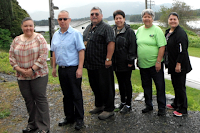 |
| Residents of Metlakatla and Lax Kw'alaams were the subject of a study into DNA and genomes published in a Scientific journal earlier this month (photo from Metlakatla First Nation) |
An outline to the research project, published earlier this month, notes that "the study of the genomes of 25 individuals who live 1,000 to 6,000 years ago on the north coast of present-day British Columbia, and 25 of their descendants who still live in the region today, opens a new window on the catastrophic consequence of European colonization for indigenous peoples in that part of the world."
Anthropology professor Ripan Mahli, co-led the new research with former graduate student Jon Lindo and Pennsylvania State University biology professor Michael DeGirgio.
The trio conducted the study and compiled their findings through the participation with residents from Lax Kw'alaams and Metlakatla. This 2016 review is a follow up to a previous study from 2013 (see here) that first developed the link between ancient individuals and the indigenous peoples of the region today.
Metlakatla was one of the first communities to participate in the study and continues to provide input to the work into DNA study. Joceylynn Mitchell, a Metlakatla co-author of the study provided a glimpse into some of the key elements towards the work, and the importance of the study, noting how their work called upon oral history to assist in the findings.
“First Nations history mainly consists of oral stories passed from generation to generation. Our oral history tells of the deaths of a large percentage of our population by diseases from the European settlers. Smallpox, for our area, was particularly catastrophic. ...We are pleased to have scientific evidence that corroborates our oral history. As technology continues to advance, we expect that science will continue to agree with the stories of our ancestors.”
Barbara Petzelt, one of the authors of the study and a liaison to the Metlakatla community also outlined how the focus on oral history was used as part of the overall review of DNA science. Highlighting how that content was applied to trace the history of the Coast Tsimshian pre and post contact.
“Oral traditions and archaeological evidence to date have shown that there has been continuous aboriginal occupation of this region for more than 9,000 years. This study adds another layer of scientific data linking the actual ancestral human remains to their modern descendants through their DNA over a span of 6,000 years,” ... “It’s exciting to see how this tool of DNA science adds to the larger picture of Coast Tsimshian pre- and post-contact history – without the taint of historic European observer bias.”
The report is designed to help to better understand the experiences of First Nations when it comes to diseas in both ancient and colonial times and the impact of European contact on their people.
The University of Illinois presented the background to their study with this information piece hosted on their news updates section of the University website.
The findings from this latest study into the First Nations on the North Coast was published on November 15th to the website for the Scientific Journal, Nature.com.
You can review the findings of the research team here.
A second article appearing in that Journal explores the impact of European diseases and the mark they left on First Nation's DNA, that study can be examined here.
You can find more items of interest on current events and developments from the two local First Nation communities from the links below:
Lax Kw'alaams
Metlakatla
Lax Kw'alaams
Cross posted from the North Coast Review
No comments:
Post a Comment